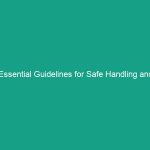Good morning team!
Today, we’re diving into an essential topic that impacts our daily operations and Safety: Extension Cord Selection. Understanding how to choose the right gauge and length of extension cords can significantly enhance our Safety and efficiency on the job site. Proper selection not only helps us avoid Electrical Hazards but also ensures our tools function optimally. Let’s explore why this is important and how you can make informed choices when it comes to extension cords.
Understanding Extension Cord Selection
Extension cords are crucial tools that extend the reach of our electrical supply to various devices and equipment. However, not all extension cords are created equal. The right selection of gauge and length is vital for safety and performance.
Many employees may think that any extension cord can suffice for any task, but this is a misconception that can lead to serious safety Hazards. Using the wrong gauge or length can cause overheating, voltage drops, and even electrical Fires.
Key Hazards, Risks, and Safety Considerations
When it comes to extension cords, the following hazards are crucial to consider:
- Overheating: A cord that is too long or has too small a gauge for the load can overheat, leading to melting insulation and potential fires.
- Voltage Drop: Longer cords can cause voltage drops that affect the performance of tools and equipment, leading to inefficient Operation or failure.
- Physical Damage: Cords that are worn, frayed, or improperly stored can lead to electric shock or short circuits.
Ignoring these risks can have serious real-world consequences, including injuries and costly downtime. It’s essential to recognize the importance of using the right extension cord to maintain a safe working Environment.
Best Practices, Procedures, & Actionable Advice
Here are some Best Practices to follow when selecting and using extension cords:
1. Determine the Right Gauge
The gauge of an extension cord indicates its thickness and capacity to handle electrical current. The lower the gauge number, the thicker the wire, and the more current it can safely carry. For example:
- 16-gauge: Suitable for light-duty requirements, such as lamps and small power tools.
- 14-gauge: Ideal for moderate-duty applications, like using larger power tools.
- 12-gauge: Recommended for heavy-duty tools and long runs; can handle significant loads.
Always check the tool’s power requirements and match them with the cord’s capacity.
2. Measure the Length
Choosing the correct length of the extension cord is equally important. Here are some tips:
- Measure the distance from the outlet to where you need power, adding a little extra length for safety.
- Avoid using excessively long cords, as they can lead to voltage drops.
- If you need to connect multiple cords, make sure they are all rated for the same load.
3. Inspect Before Use
Before using any extension cord, always inspect it for:
- Frays or cuts in the insulation.
- Loose or damaged plugs.
- Discoloration or melting.
If you find any damage, do not use the cord. Replace it immediately to avoid any potential hazards.
4. Store Properly
How you store your extension cords is just as important as how you use them. Follow these guidelines:
- Never wrap cords tightly around objects as it can damage the insulation.
- Store them in a dry area away from direct sunlight and moisture.
- Keep cords untangled and organized to prevent trip hazards.
5. Use Grounded Cords for Safety
Always choose grounded extension cords for outdoor or high-power applications. Grounded cords help to prevent electrical shocks and are essential for safety when working with powerful tools.
Regulations, Standards, and Compliance
It’s essential to understand that our use of extension cords must comply with safety Standards set forth by organizations like OSHA. Key Regulations include:
- Extension cords must be properly rated for the specific environment and load.
- Cords should have appropriate markings indicating their intended use.
- Regular inspections and Maintenance must be conducted to ensure continued safety.
Compliance with these regulations not only keeps you safe but also protects our organization from potential legal issues and financial liabilities.
Employee Engagement & Discussion
Now that we’ve covered the essentials of extension cord selection, I’d like to open the floor for some discussion. Here are a few questions to consider:
- What safety challenges have you encountered related to extension cords?
- Have you ever experienced an incident due to improper cord use?
- What Best Practices do you recommend to ensure Safe Usage?
Feel free to share your thoughts and experiences. Remember, safety is a collective responsibility, and your input is invaluable!
Conclusion & Key Takeaways
In summary, selecting the right extension cord gauge and length is vital for maintaining a safe and effective working environment. Always choose the appropriate gauge for the load, measure lengths accurately, inspect cords before use, and store them properly. Compliance with safety regulations is non-negotiable.
Let’s commit to applying these practices to keep ourselves and our coworkers safe. Thank you all for your attention and for prioritizing safety in our workplace!


